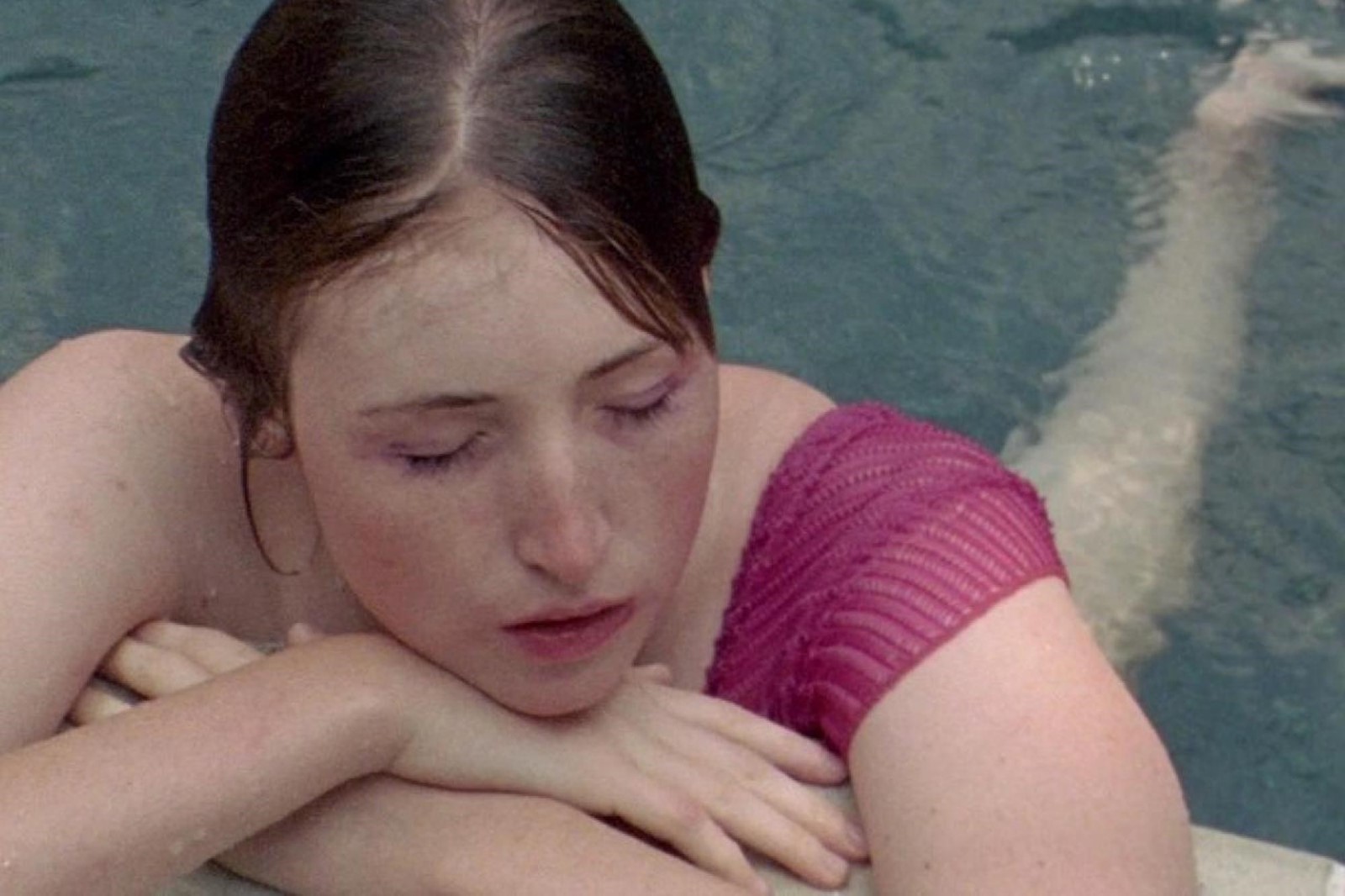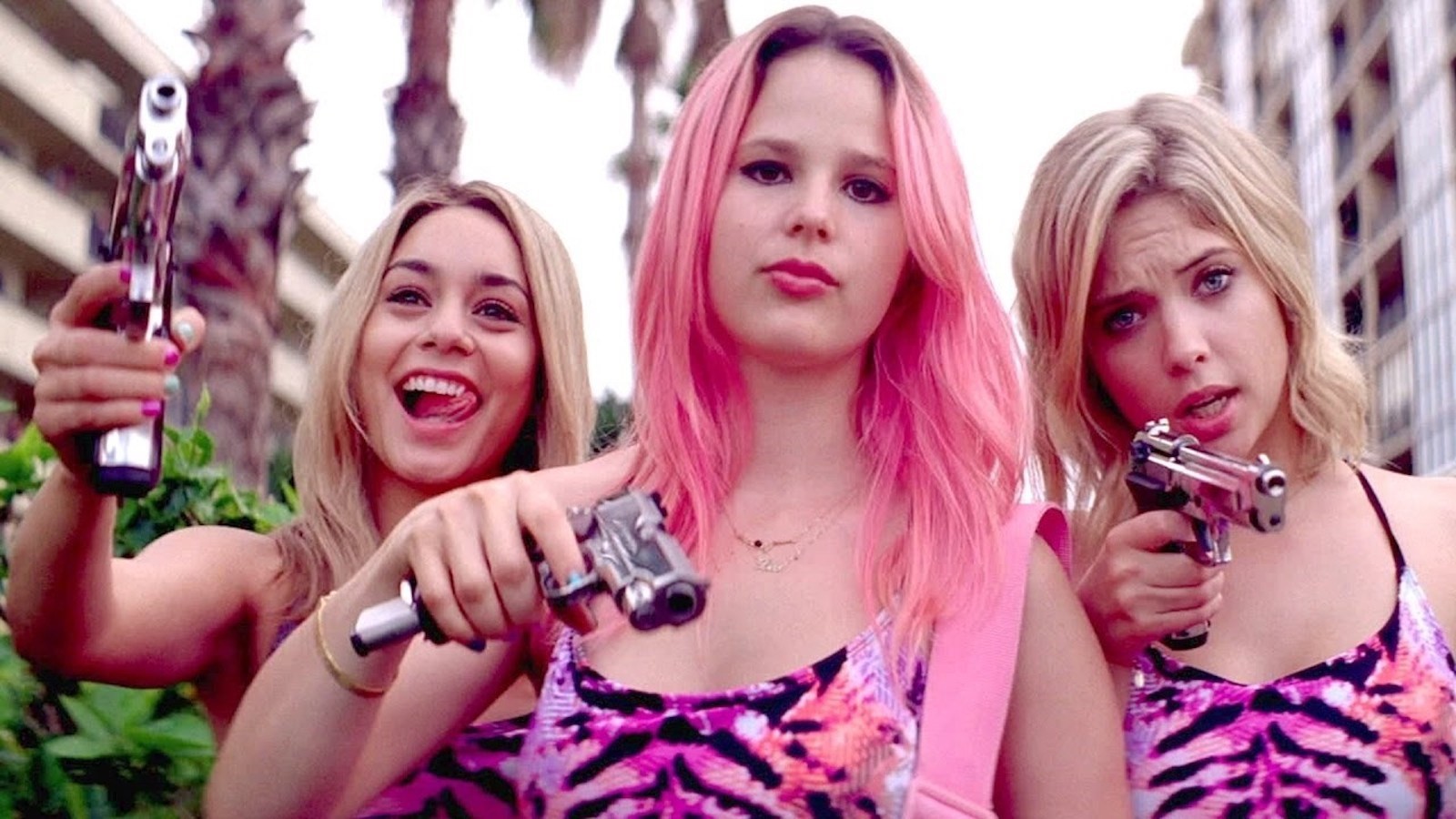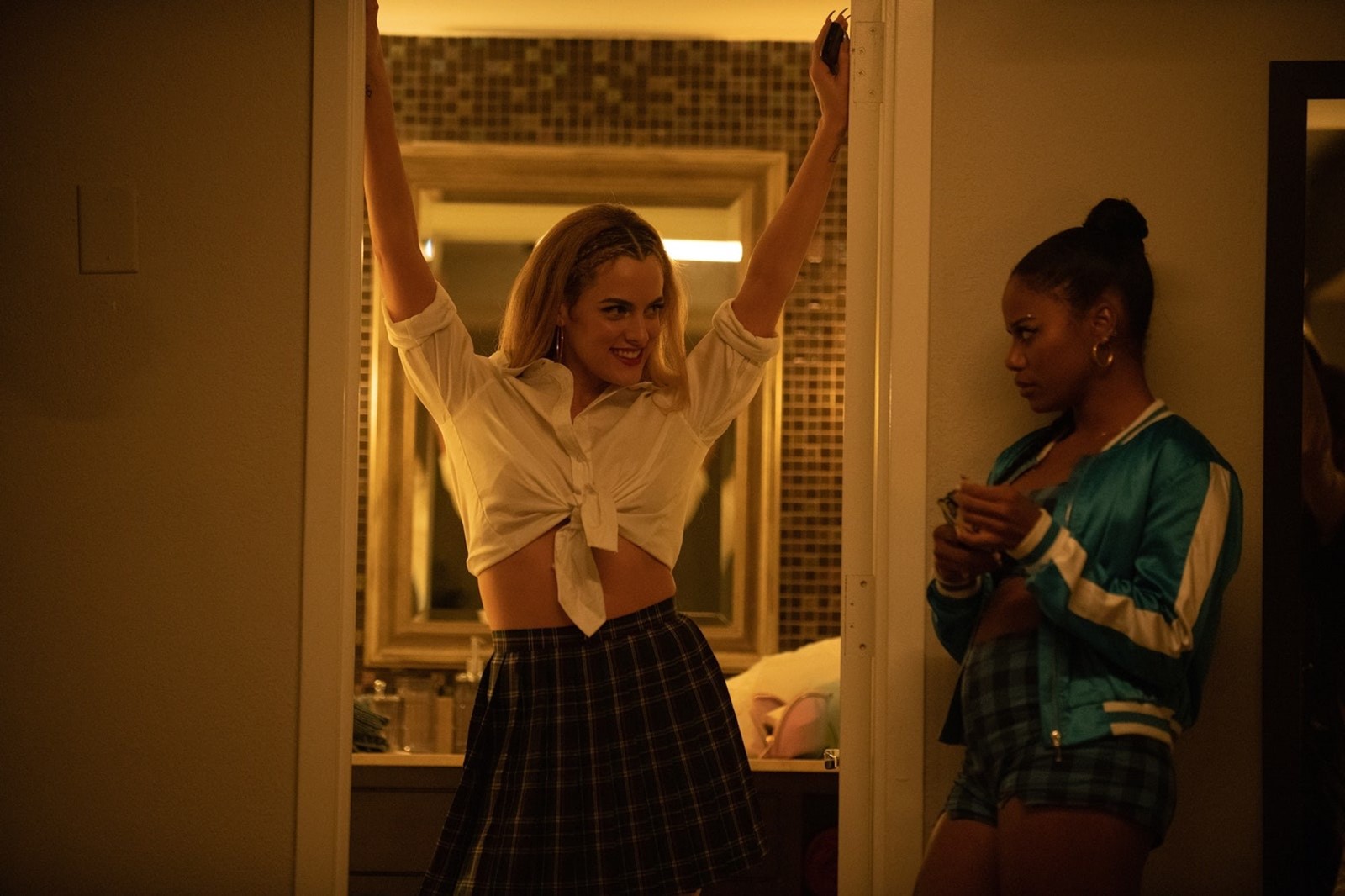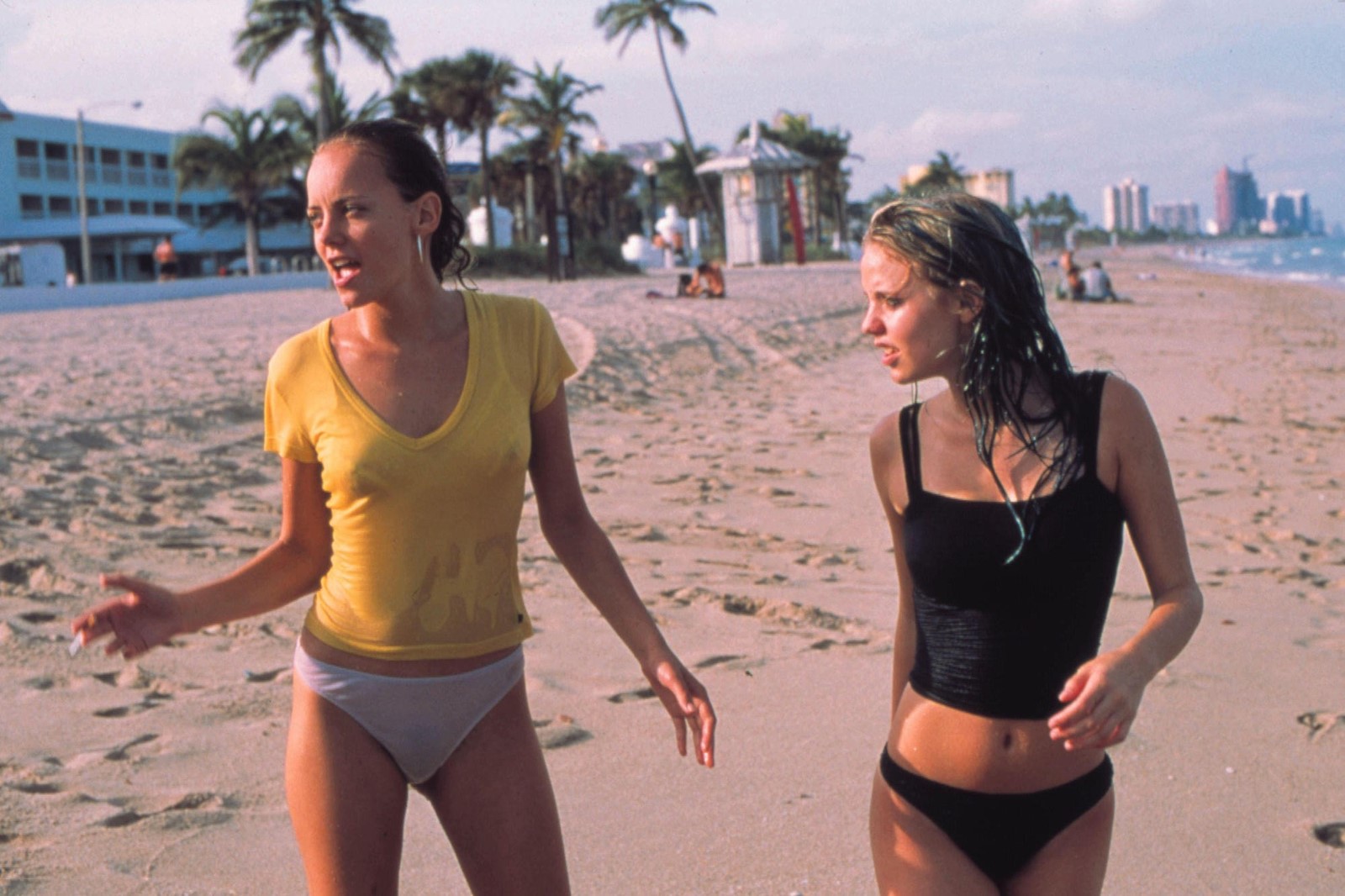Girlhood Studies: How has visual culture shaped ideas of girlhood? In the second season of her AnOthermag.com column, Claire Marie Healy continues to investigate the on-screen girlhoods we may have overlooked.
Sometime in March 2015, 19-year-old A’ziah “Zola” King got a text from a girl she had just served at Hooters.
“BITCH LETS GO TO FLORIDA!”
“huh???”
“I’m going to dance in Florida, let’s go!!”
Finally out this month in the UK, Janicza Bravo’s cinematic adaptation of @_zolarmoon’s epic Twitter stripper saga is currently painting screens neon as if to ask: so you’ve heard of Florida Man, but what about Florida girls?
Weird crimes, career crimes, accidental crimes and premeditated crimes seem to stick to the Sunshine State. The “Florida Man” meme that emerged a few years ago signalled the region’s notoriety as a place where strange and unusual events – often of a criminal nature – take place with alarming regularity, and are reported as news. On screen, Night Moves (1975), Body Heat (1981), Scarface (1983), Miami Blues (1990), Blood and Wine (1997), Pain & Gain (2013) and The Paperboy (2013), are just some of the crime films where all, or at least some, of the action takes place there. But if the screen mythology of Florida floats ideas of sex and death – often entwined closely in a single film – then comings-of-age set there have been informed by the same ideas, too.
Florida is the third largest state by population, just after California and Texas. Its famed humidity, being surrounded by the Gulf of Mexico and the Atlantic Ocean, make parts of the state as close to a tropical climate as you’ll find in the USA. Those ecological extremes, from hurricanes and thunderstorms to tropical cyclones, set the scene for a state of extreme contrasts: saccharine “Visit Florida” tourism spots like Walt Disney World and beach resorts sit alongside an urban sprawl marked by inequality, together with huge swathes of beautiful, uncontrollable nature. The vast Everglades are one of the most diverse ecosystems in the world, with alligators and snakes lying in wait that are either native, or the result of accidentally introduced species once owned by extreme pet lovers (cast your internet brain back to when everyone was watching Tiger King, if you can bear it).

From the first moments of Amy Seimetz’s Sun Don’t Shine, you’re enveloped in an atmosphere so sticky that a film of sweat forming on the laptop screen would seem appropriate. Like Zola, the 2012 film depicts a road trip across Florida with an ambiguous purpose that eventually reveals itself as something darker; unlike Zola, the snappy Twitterfied dialogue is reduced to flat, elliptical exchanges between two lovers on the run, often stated in voiceover. In fact, protagonist Crystal doesn’t even have a phone, as her boyfriend smashes it up right in those first few seconds of the film. Immediately, we see a boy, a girl, and a car (all that’s missing is the gun). The camera also catches a Florida license plate; what it doesn’t show yet is the something, or someone, in the trunk. The girl is writhing and screaming in pools of mud; she is in terrible pain, the kind you presume is something to do with something the boy has done, but which registers as so raw that maybe, in fact, it is the girl who has been bad. Crystal is played by Kate Lyn Sheil, an actress so moody that her facial expressions are like weather patterns moving in; the one constant is her red, ruddy cheeks, cheeks which give her away even in the dark shadows formed in the back seat when a car pulls out of a driveway. Like Halley in Sean Baker’s The Florida Project (played by Bria Vinaite), Crystal is a young mother who wants to do right by her daughter, but who expresses care through re-enacting a kind of permanent childhood herself. Like Baker, Seimetz contrasts the grim reality of disenfranchised young women in the state with the precarious pleasure they might take in its theme parks, rainbow sunsets, gift-shop mermaids and Disney princesses.
Seimetz’s instinct for her location’s mercurial appeal comes from her own Tampa upbringing, and a period of “hanging out in seedy bars” as she wrote the screenplay. But for other directors, Florida becomes source material in a more factual sense, through True Crime accounts that capitalise on its mythology. Actually, around half of the films listed earlier are based on true stories, and that’s without mentioning the dramatisations of notorious local serial killers like Ted Bundy and Aileen Wuornos.
Larry Clark’s underrated Bully (2001) is one such story, based on the real-life murder of 20-year-old Bobby Kent in south Florida by seven people, his best friend among them. But unlike its predecessors – noir-ish or erotic takes on real murders that have established the stereotypes of the state – Bully is acerbic, brutal and desperately sad, its violence lazy and inevitable. Since my first viewing on a borrowed DVD sometime in the aughts, Bully has stayed with me more strongly than the director’s Kids, maybe because its leading young women are not the sweet, victimised girls epitomised by Jennie in the latter film, but something like hyperactive demons. These girls are just as susceptible to falling in love with boys, but their devotion is tangled with such devastatingly warped ideas about sex, romance, and power that the acceleration of events follows a logic all of its own twisted teenscape, a kind of self-destructive hurricane that whips everyone into its current. The boys are definitely fucked-up – you should watch the film for the late Brad Renfro’s performance alone, who sadly overdosed seven years after filming – but the girls are on their own level. Bijou Phillips, playing Ali, is a hot girl on a mission, so lacking in self-awareness that you can’t help but be on her side (ironically, Phillips was exposed as the real bully years after filming). I can’t think of another film in which the hours and days after a crime progress with such realistic certitude. To watch the film is to be immersed in a world so bleak that it feels as inescapable as it must to its teenage inhabitants; as Roger Ebert wrote, “There is no doubt a parallel universe in this same suburb, filled with happy, creative, intelligent people and endless opportunities – there always is – but these kids are off that map.”

For the lighter side of teen girl crime, look to former Clark protégé Harmony Korine and his Spring Breakers (I was such a fan of the film when it came out in 2012 that I can admit my friends and I bought our own pink balaclava with a unicorn on, to take photos with). Charting the transformation of four college students from friends who can’t afford to go on Spring Break, to diner cash register robbers, to pilled-up drug lord posse, the film could only be located in Florida – not for its literal status as a popular Spring Break destination, but for the idea of a dreamscape that emphasises pure sensation. It’s the search to feel anything taken to a cliff-edge. (As a side note, I’m itching for a side-by-side comparison of Alien’s mansion with the one where Nicholas Braun does you-know-what at the end of Zola.) Korine actually stayed at home when classmates went to Florida during the spring break, but it was the pure idea of it that stayed with him. “I never went but had this image of girls on a beach with ski masks and guns robbing tourists,” the director has said. “I wanted to make a film that was more like a feeling, more this idea of these pockets in America and what happens when you get a little lost, like when they leave the strip and end up in Alien's house. Those houses on the water with guns, it’s the underbelly, but it’s more of a feeling than anything.” Here I have to quote the great Philippa Snow on the pleasantly numbing effects of Korine’s vision of sex, violence, neon, and nubile flesh, who wrote for Garage that in the process of viewing the film, the former Disney-starlet heroines “look and act less like Lolita stereotypes than like four adult-adolescent Mobius strips in booty shorts.”
Any of Korine’s chicks would fit in easily with the travelling sales boys and girls of Andrea Arnold’s American Honey (2016). A road trip with a “mag crew” through the endless plains of the American Midwest with a gang of hedonistic teenagers, the film also has its own Florida origin story, with Arnold’s lead actress Sasha Lane being first discovered by the director during her own spring break. Only 19 at the time, the dreadlocked and tattooed Lane was plucked right from among thousands of partying teenagers on Panama City Beach. Of that moment, Lane – whose tough upbringing has parallels with her character, Star – has said that it saved her life.
For directors looking to explore the darker side of girlhood, Florida has been a magnet. But as much as the experiences of real-life teenage girls in the state have slid over and under their depictions on screen, it feels like there must be a stronger reason for its pull beyond an extreme climate. Perhaps it’s that the physical proximity to fantastical, wild animals – to dangerous creatures, like alligators and giant lizards – that prove too tempting an allegory for systems that swallow up youth, spitting them out with little regard for a workable future. (It’s a jolt, in a film largely taking place in strip malls and garage driveways, when the kids of Bully so casually mention that the swamp’s gators will get rid of the evidence of their crime.)

The cultural association of Florida as a place where bad things happen is also based on a legal loophole. In more everyday terms, the idea of the state as a hive of criminal activity has been formed by its better public records laws. All those stories of weird Florida happenings dotted around the Internet will usually contain the phrase, “according to the arrest report”. For journalists, this means the state’s laws allow corruption to be more easily exposed, but it also means the details and mugshots behind crimes are extremely accessible, and in many cases posted online immediately. Rather than Florida being a kind of swamp-like ‘upside-down’ zone for evil in and of itself, it’s the nationwide media who have made the state a kind of shorthand for bad behaviour. That said, when it comes to teenagers who commit crimes in the state, it should be noted that Florida’s broad direct file law means it transfers more children to adult court than any other state. Nonetheless, there’s all kinds of racism, classism and sexism tied up in the media’s messaging of Florida as the only state where sordid crimes happen – as opposed to the only state where you’ll hear about them.
In the canon of Florida-set comings-of-age on film, the most successful confront those stereotypes and take them somewhere new, like Bully’s exposure of a culture that creates youth so disaffected that violence quickly fills the gap where hope used to be; or Sun Don’t Shine’s takedown of the idea that there is anything sexy about a cross-state murder spree. These are films in which the road across Florida feels infinite to the point of entrapment, as when Sun Don’t Shine’s couple conclude that “we’re not going to make it to the Everglades… we were probably not going to make it anyway”. The idea of Florida is like a dream that feels so far that trying to achieve it is its own kind of stuckness. In movies, forever isn’t always a good thing.
I recently read about a young Floridian designer, Elle Barbeito, who is doing the same reversal of stereotypes through her fashion: hunting the non-native Burmese python in the Everglades with her state-hired father (the pythons are killing the bird population), she recycles the usually-disposed of skins to create her clothing. A kind of craft that could only be pursued amid Florida’s extremes, it’s a perfect metaphor for the precarious struggle between overcoming the state’s nature, and its potential to overcome you.
Even in the middle of her epic Floridian Thotyssey, with guns and certain doom around every corner, Zola finds a few seconds of peace, not quite in nature, though probably still very close to danger.
"I leave & go down to the pool. I mean, I am in Florida!”
Zola is out in the UK this month.
